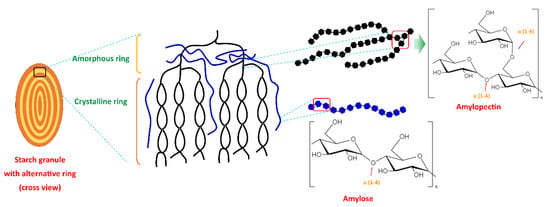You're using an outdated browser. Please upgrade to a modern browser for the best experience.
Please note this is a comparison between Version 1 by Ashoka Sriyani Gamage and Version 2 by Conner Chen.
Starch is one of the most abundant natural polymers globally. Starch and its nanocomposites have been extensively studied for their abundance, low cost, ease of processibility, and chemical and physical properties.
- biodegradability
- carbon nanotubes
- graphene
- life cycle analysis
- nanocomposites
1. Introduction
In recent days, nanocomposites have gained much attention over traditional composite materials and are widely used in food, packaging, biomedical applications, electronics, energy storage, optics, the automotive industry, bio-sorbants for environmental remediation, textiles, and many other applications [1][2][1,2]. Polymer nanocomposites consist of polymer matrices embedded with nanofillers [3]. Petroleum-based polymers are produced in huge amounts globally. Petroleum-based polymers are non-biodegradable, non-renewable, and produce hazardous substances which can threaten human health and the environment [4]. Furthermore, the depletion of these non-renewable petroleum-based fuels demands alternative resources [5].
Thus, biopolymer-based nanocomposites can be a sustainable alternative for petroleum-based nanocomposites in many applications due to their biodegradability, eco-friendliness, renewability, relatively inexpensive, low toxicity, abundancy, and improved thermal, mechanical, physical, barrier, and functional properties [3][4][3,4]. Various natural biopolymers, including starch, cellulose, pectin, lignin, chitin/chitosan, alginates, hyaluronic acid, gelatin, terpenes, gelatin, gluten, and polyhydroxyalkanoates (PHAs) from plants, animals, algae, microorganisms and synthetic biopolymers, including polycaprolactone (PCL), poly(butylene succinate) (PBS), poly(lactic-co-glycolic acids) (PLGA), and polylactic acids (PLA), have been used in nanocomposite materials for various applications [1][2][3][6][7][8][1,2,3,6,7,8].
Starch is one of the most abundant natural polymers globally. Starch and its nanocomposites have been extensively studied for their abundance, low cost, ease of processibility, and chemical and physical properties [1][4][1,4]. Furthermore, starch can be used in natural or modified form. Native starch has drawbacks, such as poor mechanical properties, high hydrophilicity, and high biodegradability. Thus, researchers are exploring starch modification techniques to improve its properties and develop novel composites [1].
Starch can be modified into nanoparticles and can also undergo various physical (milling, blending with other polymers, extrusion, plasticizers, etc.) and chemical (substitution, graft co-polymerization, cross-linking, oxidation, etherification, esterification, dual modification, etc.) modifications to produce materials with novel properties [9][10][11][12][9,10,11,12].
Starch can be reinforced with starch nanoparticle/starch nanocrystals and nano polymers such as nanoclay (montmorillonites [MMTs], halloysites nanotubes [HNTs]), carbon nanotubes (CNTs), and nanofibers and nanowhiskers (cellulose, chitin) and metal and metal oxides (TiO2 NPs, ZnO NPs, etc.) to achieve desirable properties and produce potential green sustainable nanocomposite materials [4][7][13][4,7,13]. The addition of nanofillers and additives with antioxidant and antimicrobial properties has been shown to improve or minimally affect biodegradation of starch-based nanocomposites [5][14][15][5,14,15]. Lifecycle assessments on starch and starch-based composites ensure their lower environmental impact and sustainable alternative for petrochemical-based polymers [16][17][18][16,17,18].
2. Starch
Starch is a polysaccharide and is renewable, inexpensive, biodegradable, and readily available. Starch contains two polymers (glucans) known as amylose (10–30%) and amylopectin (70–90%). Amylose is a linear chain of D-glucose units linked by the α-(1,4) glycosylic bonds, while amylopectin is a highly branched and high molecular weight chain composed of D-glucose repeating units linked by α-(1,4) glycosylic bonds and α-(1,6) glycosidic bonds. The amylopectin chain contains 10–60 glucose units, and the side chains consist of 15–45 glucose units with about 5% of α-(1,6) branching points [6][7][6,7]. Amylose and amylopectin are radially arranged in an alternating concentric (amorphous and semi-crystalline) ring in starch granules. Amylopectin is radially arranged in granules and contributes to its crystalline nature (double helices region), and single helices amylose is randomly distributed among amylopectin clusters. Amylose and the branching point of amylopectin form the amorphous region [19][20][21][19,20,21]. Figure 1 illustrates the structure of the starch granule and the chemical structure of amylopectin and amylose.
Figure 1.
Starch granule structure and the chemical structure of amylopectin and amylose.
Table 1.
Amylose and amylopectin contents of starch from various sources.
| Starch Source | Amylose (%) | Reference |
|---|---|---|
| Arrowroot | 35.52 | [27] |
| Banana (pulp) | 16.36–26.2 | [28][29][30][28,29,30] |
| Banana (peel) | 25.7 | [29] |
| Barley (regular) | 24.7 | [31] |
| Cassava | 2.5–32.12 | [28][32][33][28,32,33] |
| Corn | 0–79.05 | [28][32][28,32] |
| Maize (normal) | 22.7–28.9 | [31][34][31,34] |
| Maize (waxy) | 0.18 | [34] |
| Maize (high amylose content) | 35.5–64.8 | [34] |
| Potato | 18.6–31.9 | [28][31][32][28[,3133,32],33] |
| Rice | 0.1–28.7 | [20][35][20,35] |
| Sweet potato (normal) | 30.4 | [36] |
| Wheat | 6.2–22.8 | [31][32][31,32] |
